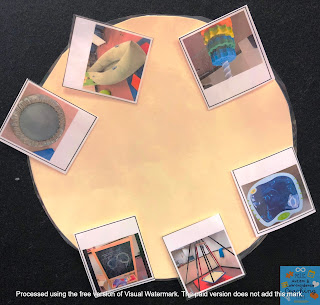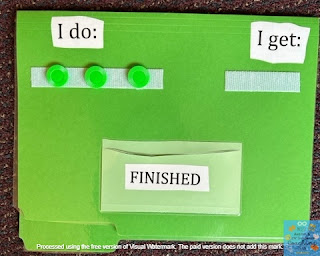Step 1: Determine what is reinforcing for the student
Autistic students are often not motivated by customary rewards, therefore it is important to find what activities or items are motivating specifically for that student. Types of reinforcement include:
- Edibles
 |
| Rebecca Leak Northwood Elementary, Northmont |
 |
| Cindy Bowling New Lebanon Elementary, New Lebanon |
- Activities
 |
| Sheyanne Olson East Elementary, Eaton |
 |
| Taylor Ruef Stevenson Elementary, Mad River |
 |
| Cassandra Hebauf Northmoor Elementary, Northmont |
 |
| Lauren Bridgens Driscoll Elementary, Centerville |
- Attention
 |
| Sarah Suarez Greenon Elementary, Greenon |
- Independent Reward
 |
| Cassandra Hebauf Northmoor Elementary, Northmont |
What do you do if the student has a very narrow set of interests? Consider looking at ways to expand their reinforcers based on features of what they like. For example, if a student loves playdoh, trial different types of playdoh such as scented or glittery playdoh. Or similar moldable doughs such as cloud dough, floam, putty, or clay. Or have the student earn making homemade playdoh.
For more ideas on expanding reinforcers, click the image below to see our handout.
You can use a Reinforcement Inventory to look for additional reinforcers. Some inventories can be completed with students while others could be completed by a family member. Click the image below to be redirected to our folder of Reinforcement Inventories.
Step 2: Create an individualized reinforcement menu
Once you determine what is reinforcing, create a reinforcement menu for the student to choose from.
 |
| Kathy Welbaum Huber Heights |
 |
| Rose Jepson Northridge Elementary, Northridge |
 |
| Hayward Middle School, Springfield |
 |
| Rylie Jarrett Stevenson Elementary, Mad River |
Step 3: Determine the Schedule of Reinforcement
When planning to implement positive reinforcement, it is important to allot time within a student's daily schedule depending on how frequently they will need reinforcement built in.
Some students need immediate reinforcement after each task or repetition of a task. This is often when edible reinforcers are used. Praise, high fives, and squeezes are additional popular immediate rewards.
 |
| Debi Gnau Mad River ECC, Mad River |
 |
| Cleveland Elementary, Dayton |
 |
| Cassandra Hebauf Northmoor Elementary, Northmont |
An immediate visual cue can also be reinforcing.
 |
| Michelle Wade Northridge Elementary, Northridge |
 |
| Lara Kearney West Carrollton High School, West Carrollton |
Other students may be able to have a more delayed schedule of reinforcement where they earn a reinforcement break following an academic subject or set of activities (such as after they return from related services).
 |
| Maggie Brackman Northwood Elementary, Northmont |
 |
| Erika Lauterback Dixie Elementary, New Lebanon |
 |
| Nichole Dunn Miamisburg Middle School, Miamisburg |
In these classrooms, the teachers naturally built-in reinforcement time for the entire class after each academic task.
 |
| Taylor Mackall Driscoll Elementary, Centerville |
 |
| Heather Clark Saville Elementary, Mad River |
 |
| Ashley Watson Madison Park Elementary, Trotwood |
Occasionally we work with students who can wait for longer periods of time before their reinforcement is received. This may mean reinforcement breaks 1-2x daily or time to choose from a prize box at the end of the day.
 |
| Nichole Dunn Miamisburg Middle School, Miamisburg |
 |
| Nichole Dunn Miamisburg Middle School, Miamisburg |
 |
| Gretchen Jones Northridge Elementary, Northridge |
| Haley Urschel Perrin Woods Elementary, Springfield |
 |
| Rylie Cruse Brookville Elementary, Brookville |
 |
| Amy Day Englewood Elementary, Northmont |
 |
| Rebecka Stricker Springcreek Primary, Piqua |
 |
| Lisa Mossing Beverly Gardens Elementary, Mad River |
 |
| Lydia Smith Greenon Elementary, Greenon |
 |
| Genevieve Harvey Walter Shade ECC, West Carrollton |
 |
| Rose Jepson Northridge Elementary, Northridge |
 |
| Smith Elementary, Oakwood |
 |
| Jolynne Rodgers Mad River ECC, Mad River |
Step 4: Clearly Define Expectations for Reinforcement using Visual Supports
Visual supports can be an extremely effective way to help students better understand what expectations are.
- Task Completion Edible Container: After each task, the student earns their reinforcer in the corresponding compartment.
 |
| Mandy Schetter Northmoor Elementary, Northmont |
 |
| Darla Wesley Cleveland Elementary, Dayton |
- Behavior-Special Edible Container: When targeting specific replacement behaviors (i.e. sitting, quiet mouth, nice hands, etc.), use visual cues to label the pillbox. Then, as the student displays the targeted behavior, provide praise and the edible from that compartment.
 |
| Julia Spencer Fairborn Primary, Fairborn |
 |
| Mandy Schetter Northmoor Elementary, Northmont |
 |
| Cassandra Hebauf Northmoor Elementary, Northmont |
- Visual Contract Folder: The visual contract folder is a folder with pictures of reinforcing items on the inside (reinforcement menu) and tokens on the outside. The tokens represent the number of tasks (graphic organizer, book, worksheet) or parts of a task (cut, glue, color worksheet) and show the student exactly what needs to be completed to earn the reinforcer. When using the visual contract, the first step during work time is asking the student what they want to work for. This immediately gets their attention and buy-in. Then, using the tokens, prime them for what work needs to be completed. As students complete their work, they take off the corresponding token and place it on the inside of the contract. Once all of the work is complete and all of the tokens have been removed, the student earns the reinforcer.
 |
| Taylor Ruef Stevenson Elementary, Mad River |
 |
| Laurie Maravetz Hayward Middle School, Springfield |
- Token Board: This format is similar to the visual contract folder described above but may be on a piece of cardstock or other laminated card. Approaches vary between having tokens that student's remove as work is completed (great for visually displaying work "going away" to address escape behaviors) vs. earning tokens as work is completed.
 |
| Granville Bastin Preble County ESC, Preble |
 |
| Rebecca Leak Northwood Elementary, Northmont |
 |
| Granville Bastin Preble County ESC, Preble |
- Special Interest Contracts/Token Boards: When you incorporate special interests into the reinforcement system, it can make it extra reinforcing because it automatically has a positive association. This is great for getting buy-in. You can use special interest backgrounds and/or tokens.
 |
| Emily Collura Primary Village North, Centerville |
 |
| MaKynzie Lowery Learning Center West, MCESC |
 |
| Denise Williams Twin Valley South Elementary, Twin Valley South |
 |
| Allie Clements Schnell Elementary, West Carrollton |
 |
| Claire Jamito Fairborn Primary, Fairborn |
 |
| Rylie Jarrett Stevenson Elementary, Mad River |
 |
| Allie Clements Schnell Elementary, West Carrollton |
 |
| Riley Cruse Brookville Elementary, Brookville |
- Dry Erase Contracts: These are another great option for providing predictability to students so they know exactly how much work is expected.
 |
| Julie Omondi Normandy Elementary, Centerville |
 |
| Cassandra Hebauf Northmoor Elementary, Northmont |
- Visual Contract To Do List: Using a visual contract to provide a list of what needs to be done to complete an assignment is a great way to break assignments down to make students feel more successful. When setting up the To Do list for an assignment, start off with steps that you know will be easy for the student such as picking up their pencil, writing their name, etc. to build positive behavior momentum. The final thing should be whatever reinforcer they wants to work for. It is very important with this tool that the student is the one checking off the items he has completed because everyone loves the satisfaction of accomplishing an item on our to do lists! Research actually shows that checking off a list releases dopamine in the brain! Plus as the student checks tasks off they will see that they are getting closer to the goal of the reinforcing item or activity. Additionally, having the assignment steps in writing makes the task less negotiable because you can refer to the list rather than engaging in a power struggle or debate.
 |
| Jolene Allen Brantwood Elementary, Mad River |
 |
 |
| VeraKaye Sowers Northridge Elementary, Northridge |
 |
| Sheyanne Olson East Elementary, Eaton |
- Behavior-Specific Contracts: When targeting specific replacement behaviors, you can develop a contract that outlines expectations and what reinforcement will be for displaying the expected behaviors.
 |
| Nichole Dunn Miamisburg Middle School, Miamisburg |
 |
| Haley Urschel Perrin Woods Elementary, Springfield |
Step 5: Consistently Provide Reinforcement
One of the most essential elements of effective reinforcement is making it consistent! Communicate with classroom staff, paraprofessionals, inclusion teachers, and related service providers so that they clearly understand the reinforcement system and can carry it over when they are working with the student.
Step 6: Analyze Your Data
Once you consistently implement the reinforcement system for 4-6 weeks, you can evaluate your data to determine its effectiveness. Ask yourself the following:
- Is the student completing more work?
- Are interfering behaviors decreasing while target replacement behaviors are increasing?
- Is the student still enjoying the reinforcers you provided on the reinforcement menu?
- Reexamine your reinforcement menu.
- Consider increasing the schedule of reinforcement and decreasing the task demands to earn reinforcement.
- Retrain staff to make sure everyone is using the reinforcement system with fidelity.
- Make sure the visual supports are concrete enough for the student to fully understand the expectations.


























No comments:
Post a Comment